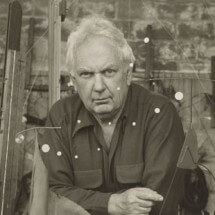The imaginative sculptures of Alexander Calder have changed modern conceptions of three-dimensional art. Calder is one of the great names of 20th century. His stabiles and mobiles can be found in almost every major museum throughout the world.
Born in Lawnton, Pennsylvania on July 22, 1898, Alexander “Sandy” Calder graduated from Stevens Institute of Technology in Hoboken, N.J. with a degree in mechanical engineering. He came from a long lineage of artists, his Scottish grandfather sculpting for the city of Philadelphia and his mother attending the Académie Julian, the Sorbonne, and the Philadelphia Academy of Fine Arts.
His younger sister Margaret even ended up following in the family’s artistic tradition too. His father was also a sculptor, instrumental in the foundation of University of California Berkeley’s Art Museum. When “Sandy” was only 4 years old, he posed for his father’s sculpture, “The Man Cub” (now located at the Met in Manhattan) and completed his very own first sculpture of a clay elephant.
Throughout his youth, his family moved from state to state, leaving Pennsylvania for Arizona, California, and New York. While a student in New York State, Calder befriended painter Everett Shinn. Because of his parents’ work, he continued to travel between New York and California, eventually staying with friends to finish high school in San Francisco in 1915.
In 1919, Calder studied mechanical engineering at Stevens Institute of Technology in Hoboken, New Jersey. For a few years after receiving his degree, Calder worked on ships, for electric companies, as a hydraulic engineer, and a draughtsman. While working on one of the ships, he took leave to visit his sister in Aberdeen, Washington. While he was there, he was inspired to pick up his paint brushes and once again pursue his art. At that point, he decided to move back to New York and pursue his passion in the arts as a career.
He attended the Art Students League in New York City, studying with Thomas Hart Benton, George Luks, Kenneth Hayes Miller, and John Sloan. While working for a local gazette, Calder was exposed to the Ringling Brothers Circus and this moment inspired many of the themes in his future work. In 1926, he established a studio in Paris in the quarter of Montparnasse. Three years later, he met his future wife, Louisa James, who was the grandniece of writer, Henry James. While he was in Paris, Calder befriended a number of artists, including Joan Miró, Jean Arp, Piet Mondrian, and Marcel Duchamp.
In 1933, Calder and his wife returned to the United States, living on a farm in Roxbury, Connecticut. Alexander and Louisa began a family in Connecticut, traveling from time to time, and they remained there until his death in 1976. His death was unexpected and immediately followed the opening of his major retrospective show at the Whitney Museum in Manhattan.
Hundreds of Joan Miró’s Letters Published for the First Time « The Official Blog of Park West Gallery[...] Picasso, Miró, Calder at San Diego Mus...
Mirό of Majorca « The Official Blog of Park West Gallery[...] Picasso, Miró, Calder at San Diego Mus...




